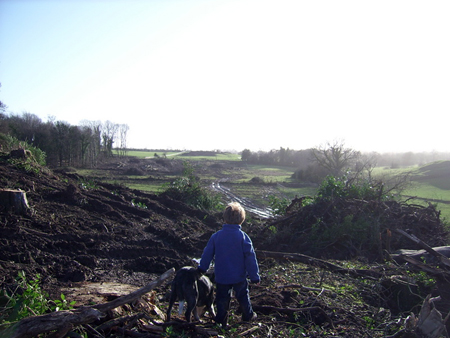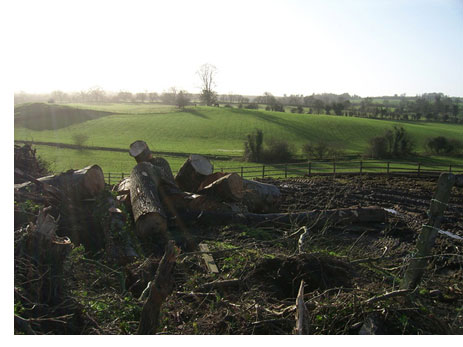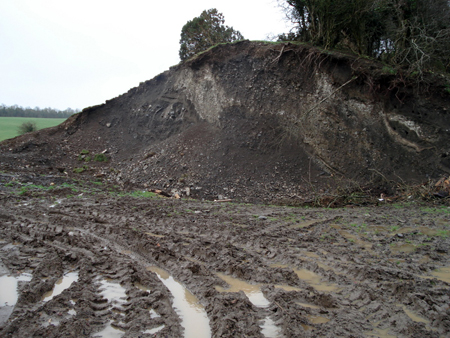Marc's Free Blog
A master list of journal articles, reviews, features, and news to various webpages around the net. These are my free gifts to you.
Vicrtorian writers often assumed that stone market crosses in many villages in the British Isles were replacements for the original wooden crosses erected by saints and priests in the early days of Christianity. But in the early 20th century a man named John Irwin pointed out that as early amateur archaeologists began exploring the remoter parts of Britain they found sculpted stones with more obviously pre-Christian markings and clearly phallic shapes. Some of the local people even maintained customs that were associated with these stones. Unfortunately, some of these Victorians, coming on objects which they found too embarrassing for a 19th century audience, seem to have quietly broke, or buried some of these objects. The phallic-shaped Clackmannan Stone, located east of Stirling, is one of the few to have survived, and stands a short distance from a later market cross. Another stone, the Longholm Mercat (market cross) was unearthed by road construction crew, and is again, a shaft with a knob on the top. It was found to have a cross inscribed in it?s top which is believed to be a later addition. These more phallic stones are suggested to have been the early inspiration for many later market crosses in the form of a tall shaft with a ball or knob at the top. Although they are not actually cross-shaped, these have come to be called market crosses as a generic term since many had crosses as additional decorations on the top, and since they have been used for similar community purposes as actual cross-shaped monuments in villages and towns. The symbolism behind these monuments is often said to be that of the world axis -the link between heaven and earth. The ball or sphere at the top may represent heaven, the spiritual state, or even the sun. The shaft is the world-axis or bridge between heaven and earth and the common square base represents the earth. More on these monuments and some of the symbols associated with them next month. ----------------------- If you enjoy our newsletter, please support it by visiting out our online stores, or seek us out at the events listed on our web sites. The Celtic Croft & MacGregor Historic GamesAnd if you like Irish music, check out the Brobdingnagian Bards new CD, The Holy Grail of Irish Drinking Songs, my new CD Irish Drinking Songs: The Cat Lover's Companion, or Victims of Irish Music. And if you're ready for more St. Patrick's Day music, check the link.Labels: ireland, irish history
posted by Marc Gunn @ Saturday, July 14, 2007
From the Celtic History Newsletter:Last month I said that one of the more notable changes started by the early Irish farming culture was in the burial of their dead. There is little surviving evidence of burial customs among the earlier hunter-gatherer peoples of Ireland, but starting around 4000 BC we see the first funerary monuments in the form of megalithic structures consisting of massive rocks that were often covered with soil and sod. These late stone age large stone constriuctions were actually a custom throughout Atlantic Europe and pre-date the numorous stone circles that were assembled later during the Bronze Age. Around 1500 megalithic tombs have been identified in Ireland. Little is known about the homes or social organization of these tomb builders, but it is clear from the size of some of the monuments that they must have had a fairly well organized social structure. The huge mound at Newgrange is estimated to contain 200,000 tons of stones. Using sledges, logs as rollers, levers and counter-weights as tools, various calculations have said that it would have taken 300 or 400 laborers as long as 20, or 30 years to transport the materials and construct this mound which cover an area of over an acre. These tombs are divided into 4 styles Wedge Tombs are the most common in Ireland, with over 400 that have been identified by archaeologists. They are called 'wedge' tombs because of their distinctive shape, being taller and wider at the front, and lower and narrower at the rear. These date from the later end of the Irish Neolithic period up to the Bronze Age with some dates showing them to be between 3000 and 4000 years old. Passage tombs: (Such as NewGrange, see link above, as well as) where the burial chamber is reached along a distinct, and usually low, passage. later ones, are sometimes covered with a cairn of earth or rocks. Most of the passage tombs were constructed aroun 3,000 B.C. Court Tombs: A long rectangular or trapezoid cairn was raised over several burial chambers. The tombs had an elongated curve of stones delineating an outer area at their entrances, called a court or forecourt which usually faces the east. The cairns can be up to 30 meters long, 14 meter wide at front and 7 wide at rear. In some cases the courts appear to have been designed to accomodate the mourners at the burials. There are over 300 Court tomb sites in Ireland, located mainly in the upper half of the country. Common artifacts found in court tombs include sherds of round bottomed pottery bowls, leaf or lozenge shaped flint arrowheads and hollow scrapers made from flint. Also a few javelin heads and polished stone axe heads have been recorded. Portal Tombs: (once called Dolmens) These are more common in western Ireland and may be the best known of the Irish burial tombs, possibly due to some impressive and easily accessible sites still remaining. The people who built portal tombs seem to have had some connections or similarities to the court tomb builders since similar artifact have been found with both, and they both tend to appear in lowland settings. For the most part these all of these tombs were used for communal burials for cremated remains not for single bodies. It has also been suggested that some of the tombs may have been more than simple burial monuments to ancestors and possibly created as declarations of territorial rights. ----------------------- If you enjoy our newsletter, please support it by visiting out our online stores, or seek us out at the events listed on our web sites. The Celtic Croft & MacGregor Historic GamesAnd if you like Irish music, check out the Brobdingnagian Bards new CD, The Holy Grail of Irish Drinking Songs, Irish Stout's A Collection of Irish Pub Songs, or Victims of Irish Music. And if you're ready for more St. Patrick's Day music, check the link.Labels: ireland, irish history
posted by Marc Gunn @ Sunday, May 13, 2007
Yesterday, Andrew and I were back in the studio working on Real Men Wear Kilts. It was a lighter workday than usual. Gigs are forcing us to take a step back. In April, we'll jump back into the studio with fervor, but too many gigs in March to do just that. This weekend, we fly to New York for I-Con. The following weekend, we'll perform at Four Winds Renaissance Faire. With all the gigs, I can barely keep up with many podcasts. Heck! I can barely organize all my blog entries to find out which one to link to. hehe. Ah well... Yesterday, I booked my flight to Ireland with a return trip via Rome. I also listened to more mixes for my Irish Drinking Songs: The Cat Lover's Companion CD that Ari sent me. I'm still hoping that I'll have that done by the end of April. But we'll see. Still lots to do. Heck! I don't have a CD cover for that yet. Hmm... Other things on my list to do: I'm sure there's more to do, we'll stop there for now. Labels: cat cd, ireland, irish drinking songs, podcasts, studio recording
posted by Marc Gunn @ Tuesday, March 20, 2007
From the Celtic History Newsletter:It was about 11 thousand years ago that the last Ice Age started coming to a close, and the bare of Ireland was colonized quickly by plant species such as grasses, dock and meadowsweet, followed by juniper, willow, birch and hazel. It was about 10,000 years ago that the first know human inhabitants came to what would become Ireland. Although the levels of the ocean were still lower than they are today, it is likely that there was already open water between Ireland and continental Europe. Thus the first peoples to arrive in Ireland would have had to come across by boat or raft, making the east coast of Ireland the most likely location for the first settlements. Although probably at least semi-nomadic these mesolithic peoples seem to have settled primarily along river banks, lake shores and the coast. These areas probably provided a ready supply of food for a hunter-gatherer population. There were few large animals in Ireland at the time. The giant Irish deer (with a antler span as wide as 3 meters) became extinct in a resurgence of cold temperatures just before the end of the Ice Age. A smaller deer-like animal, as well as the red deer were present, but the surviving evidence suggests that wild pigs, in addition ton game birds were the primary quarry of the earliest inhabitants of Ireland. Hazelnuts were easy to store and probably an important resource over the winter until the salmon run began in spring. It is believed that in similar settlements in Britain that the inhabitants may have used fire to clears sections of woodland in the hope of attracting animals who grazed in more open areas. In County Antrim there are layers in of soil dating to about 6000 B.C. that show charcoal layers and a change in plant pollen that suggest the earliest Irish may have done the same. However, it seems that they did not modify their environment to a great deal, but rather exploited the existing resources. Excavations on Mount Sandel in County Derry and overlooking the estuary of the Lower Bann have found the earliest know occupation of Ireland dated between 7000 and 6650 B.C. based on radiocarbon dating. Although centuries of farming and plowing fields may have destroyed much evidence, a number of post-holes were found in arcs which were centered around fire pits. These huts were about 6 meters across and seem to have been made of saplings set into the ground and probably woven together to make an inverted basket, or possibly a tepee-shaped shelter. Although animal bones do not often survive in the acidic soils of the Mount Sandel area, the inhabitants through a number of bones into their fires, and the surviving fragments give us a picture of the diet the residents. Over three hundred bones were found one from a dog, three from hares and although there were some bird and fish bones as well most of the rest came from wild pigs. It's not until the about the 4000 B.C. during the Neolithic period that the first evidence of farming appears in Ireland. A little more on the earliest Irish peoples next month ----------------------- If you enjoy our newsletter, please support it by visiting out our online stores, or seek us out at the events listed on our web sites. The Celtic Croft & MacGregor Historic GamesAnd if you like Irish music, check out the Brobdingnagian Bards new CD, The Holy Grail of Irish Drinking Songs, Irish Stout's A Collection of Irish Pub Songs, or Victims of Irish Music. And if you're ready for more St. Patrick's Day music, check the link.
Labels: ireland, irish history
posted by Marc Gunn @ Tuesday, March 13, 2007
MINISTER'S DIRECTIONS FLOUTED IN THE GABHRA VALLEY National University of Ireland, at Maynooth, archaeologist and Celtic studies lecturer Dr Muireann Ní Bhrolcháin of the Save Tara campaign has written to the Minister and the Taoiseach regarding the works being undertaken on behalf of the National Roads Authority (NRA) / Meath County Council (MCC) along the section of the proposed route of the M3 motorway in the Gabhra Valley, near to the Hill of Tara, in Co. Meath. The message says that the tree felling and use of heavy digging machinery at Lismullin and at the base of Rath Lugh (one of Tara's outlying defensive fortifications) is not being carried out in accordance with the Minister's directions. It seems that standards of best archaeological practice are not being observed and that the directions are being openly flouted.
 When the Minister gave directions on May 11th 2005 he said that: "the removal of forestry and topsoil at Lismullin and Ardsallagh will be carried out under archaeological supervision; all construction topsoil stripping will be archaeologically monitored." There is no archaeological supervision of forestry clearance at Lismullin. Neither is there any archaeological monitoring of large-scale earthmoving from the base of the Rath Lugh scarp. Such actions completely undermine Rath Lugh and the assurances given by the Minister in relation to this, one of our nation's most sensitive archaeological and historical landscapes. It must be assumed that the Minister and his senior archaeologist must know of this work that is in direct breach of the directives.
back to top
 Rath Lugh is an important national monument in its own right but, as an integral part of Tara, its significance is even greater. It stands as a sentry over the Gabhra Valley guarding the northern and north-western approaches to the Hill and overlooks other nearby recorded archaeological monuments, namely a barrow and souterrain. It is extremely likely that other monuments that are not visible on the surface are also found within its immediate vicinity. Photographs show the destruction at the base of Rath Lugh – the stratified archaeological sediments can be seen in the right of photo below. If there were archaeological supervision such works would have been brought to a halt at the first sight of potential archaeological features. Heavy machinery, whether supervised or not, should not have been used or permitted in this area. Why is it necessary to commence such work under cover of darkness? This remains a mystery to all except, of course, those who sanctioned the work in the first instance. Health and Safety concerns aside, it is unlikely that someone will see freshly disturbed archaeological features in the dark – even if an archaeologist were present armed with miner's helmet and infra-red goggles. The Minister also said in a statement on May 11th 2005: "The directions which I have given represent a measured approach. They are both comprehensive and onerous. They protect heritage." In fact, it appears that the Minister’s expressed wishes are being 'comprehensively' ignored.
 Save Tara is asking the NRA / MCC to halt all work immediately along this section of the M3 as The PPP has not yet been signed. We ask that an enquiry be held into why such work was authorised and who was responsible for approving it. Save Tara calls again on opposition spokespersons to ask for this work to stop forthwith. Contact: Dr Muireann Ní Bhrolcháin, Save Tara, http://www.savetara.com back to top Labels: ireland, save tara
posted by Marc Gunn @ Sunday, February 04, 2007
Embrace
Indie Celtic music!
• Buy CDs
• Buy Celtic T-Shirts
• iTunes Music Store
• Celtic Songs and Folk Music Downloads
• Gunn Runners Club


Blogs
Previous Posts
Archives
|
|





